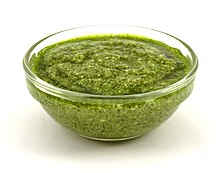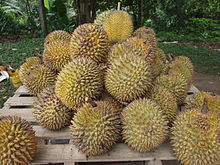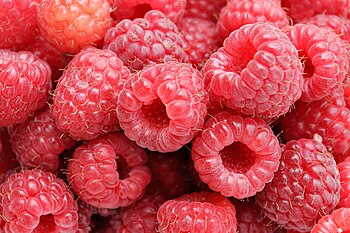Portal:Food
F o o d
A portal dedicated to food and foodways
Introduction


Food is any substance consumed by an organism for nutritional support. Food is usually of plant, animal, or fungal origin and contains essential nutrients such as carbohydrates, fats, proteins, vitamins, or minerals. The substance is ingested by an organism and assimilated by the organism's cells to provide energy, maintain life, or stimulate growth. Different species of animals have different feeding behaviours that satisfy the needs of their metabolisms and have evolved to fill a specific ecological niche within specific geographical contexts.
Omnivorous humans are highly adaptable and have adapted to obtain food in many different ecosystems. Humans generally use cooking to prepare food for consumption. The majority of the food energy required is supplied by the industrial food industry, which produces food through intensive agriculture and distributes it through complex food processing and food distribution systems. This system of conventional agriculture relies heavily on fossil fuels, which means that the food and agricultural systems are one of the major contributors to climate change, accounting for as much as 37% of total greenhouse gas emissions. (Full article...)
Cooking, also known as cookery or professionally as the culinary arts, is the art, science and craft of using heat to make food more palatable, digestible, nutritious, or safe. Cooking techniques and ingredients vary widely, from grilling food over an open fire, to using electric stoves, to baking in various types of ovens, reflecting local conditions. Cooking is an aspect of all human societies and a cultural universal.
Preparing food with heat or fire is an activity unique to humans. Archeological evidence of cooking fires from at least 300,000 years ago exists, but some estimate that humans started cooking up to 2 million years ago.
The expansion of agriculture, commerce, trade, and transportation between civilizations in different regions offered cooks many new ingredients. New inventions and technologies, such as the invention of pottery for holding and boiling of water, expanded cooking techniques. Some modern cooks apply advanced scientific techniques to food preparation to further enhance the flavor of the dish served. (Full article...)
The Modern Cook was the first cookery book by the Anglo-Italian cook Charles Elmé Francatelli (1805–1876). It was first published in 1846. It was popular for half a century in the Victorian era, running through 29 London editions by 1896. It was also published in America.
The book offered elaborate dishes, described with French terminology such as bisque, entrées, entremets, vol-au-vent, timbale and soufflé. It included bills of fare for meals for up to 300 people, and for a series of eight- or nine-course dinners served to Queen Victoria; one exceptional royal dinner in 1841 had sixteen entrées and sixteen entremets, including truffles in Champagne. (Full article...)
Selected article –
A tamale, in Spanish tamal, is a traditional Mesoamerican dish made of masa, a dough made from nixtamalized corn, which is steamed in a corn husk or banana leaves. The wrapping can either be discarded prior to eating or used as a plate. Tamales can be filled with meats, cheeses, fruits, vegetables, herbs, chilies, or any preparation according to taste, and both the filling and the cooking liquid may be seasoned.
Tamale is an anglicized version of the Spanish word tamal (plural: tamales). Tamal comes from the Nahuatl tamalli. The English "tamale" is a back-formation from tamales, with English speakers applying English pluralization rules, and thus interpreting the -e- as part of the stem, rather than part of the plural suffix -es. (Full article...)Selected cuisine -

Selected ingredient –

Stock, sometimes called bone broth, is a savory cooking liquid that forms the basis of many dishes – particularly soups, stews, and sauces. Making stock involves simmering animal bones, meat, seafood, or vegetables in water or wine, often for an extended period. Mirepoix or other aromatics may be added for more flavor. (Full article...)
Selected recipe –

Pesto (Italian: [ˈpesto]) or more fully pesto alla genovese (Italian: [ˈpesto alla dʒenoˈveːse, -eːze]; lit. 'Genoese pesto') is a paste made of crushed garlic, pine nuts, salt, basil leaves, grated cheese such as Parmesan or pecorino sardo, and olive oil. It originated in the Italian city of Genoa, and is used to dress pasta and sometimes soups. (Full article...)
The durian (/ˈdʊəriən/, /ˈdjʊəriən/) is the edible fruit of several tree species belonging to the genus Durio. There are 30 recognized Durio species, at least nine of which produce edible fruit. Durio zibethinus, native to Borneo and Sumatra, is the only species available on the international market. It has over 300 named varieties in Thailand and 100 in Malaysia as of 1987. Other species are sold in their local regions.
Named in some regions as the "king of fruits", the durian is distinctive for its large size, strong odour, and thorn-covered rind. The fruit can grow as large as 30 cm (12 in) long and 15 cm (5.9 in) in diameter, and it typically weighs 1 to 3 kg (2.2 to 6.6 lb). Its shape ranges from oblong to round, the colour of its husk from green to brown, and its flesh from pale yellow to red, depending on the species. (Full article...)Selected image –
Selected biography –
Alain Ducasse
B. September 13th 1956
Alain Ducasse (French: [alɛ̃ dykas]; born 13 September 1956) is a French-born Monégasque chef. He operates a number of restaurants including Alain Ducasse at The Dorchester which holds three stars (the top rating) in the Michelin Guide. (Full article...)
Did you know (auto-generated) –

- ... that a New York pop-up restaurant opened by Louisa Shafia served stews and rice dishes described in a review as a "Persian-tapas gateway into the ancient cuisine"?
- ... that the Sonoran blue butterfly uses Dudleya cymosa subsp. pumila as a larval foodplant and hummingbirds feed on its nectar?
- ... that food YouTuber Mike Chen also runs a channel documenting strange phenomena?
- ... that the Unitized Group Ration – Express is designed to heat food itself without the need of a field kitchen?
- ... that Binggrae, a South Korean food and beverage company, was the official ice cream supplier of the 1988 Seoul Olympics?
- ... that Foodbank Canterbury receives products from a prison?
More did you know –
Related portals
Food topics
The following are topics relating to food
Categories
Food list articles
- See also: Lists of foods and Category:Lists of drinks
The following are some Food list articles on Wikipedia:

- American cheeses
- Appellation d'Origine Contrôlée cheeses
- Apple cultivars
- Bacon dishes
- Bacon substitutes
- Basil cultivars
- Breads
- Breakfast beverages
- Breakfast cereals
- Breakfast foods
- British cheeses
- Cakes
- Candies
- Cheeses
- Cheese soups
- Christmas dishes (list)
- Cocktails
- Cookies
- Dishes using coconut milk
- Diets
- Doughnut varieties
- Egg dishes
- Fermented soy products
- Food additives
- Food additives (Codex Alimentarius)
- Foods named after people
- French cheeses
- French dishes
- Fried dough foods
- Fruits
- List of hamburgers
- Herbs and spices
- Hors d'oeuvre
- Indian dishes
- Indian snack foods
- Indonesian dishes
- Italian dishes
- Japanese snacks
- Japanese dishes
- Jewish dishes
- Kebabs
- Korean beverages
- Mango cultivars
- Moroccan dishes
- Pasta
- Pastries
- Philippine snack food
- Pies, tarts and flans
- Poppy seed pastries and dishes
- Potato dishes
- Puddings
- Raw fish dishes
- Rice dishes
- Rolled foods
- Sauces
- Seafood
- Seeds
- Sandwiches
- Snack foods
- Soft drinks by country
- Soul foods and dishes
- Soups
- Stews
- Street foods
- Tapas
- Turkish dishes
- Twice-baked foods
- Vegetable oils
- Vegetables
- Vodkas
Things you can do
Related WikiProjects
| Parent project: WikiProject Food and Drink | |
| Child projects: | Task forces: (All inactive) |
|
|
| Related projects: | |
New articles
Rules | Match log | Results page (for watching) | Last updated: 2024-05-20 19:47 (UTC)
Note: The list display can now be customized by each user. See List display personalization for details.
- Pao Alentejano (edit | talk | history | links | watch | logs | tools) by Valereee (talk · contribs · new pages (12)) started on 2024-05-20, score: 10
- Sir Grapefellow and Baron von Redberry (edit | talk | history | links | watch | logs | tools) by Retrosunshine2006 (talk · contribs · new pages (1)) started on 2024-05-20, score: 20
- Pharasmanes II (edit | talk | history | links | watch | logs | tools) by BilledMammal (talk · contribs · new pages (145)) started on 2024-05-19, score: 10
- Kinamatisang manok (edit | talk | history | links | watch | logs | tools) by Obsidian Soul (talk · contribs · new pages (17)) started on 2024-05-19, score: 10
- Federal Food, Drug, and Cosmetic Act of 1938 (edit | talk | history | links | watch | logs | tools) by Irruptive Creditor (talk · contribs · new pages (1)) started on 2024-05-19, score: 10
- IT'SUGAR (edit | talk | history | links | watch | logs | tools) by AbsentPat (talk · contribs · new pages (2)) started on 2024-05-19, score: 20
- Harvey's Butter Rum Batter (edit | talk | history | links | watch | logs | tools) by AbsentPat (talk · contribs · new pages (2)) started on 2024-05-19, score: 20
- Mar-Jac Poultry (edit | talk | history | links | watch | logs | tools) by TJMSmith (talk · contribs · new pages (16)) started on 2024-05-18, score: 10
- Festival del Sole (edit | talk | history | links | watch | logs | tools) by 87.74.175.29 (talk · contribs · new pages (2)) started on 2024-05-18, score: 20
- Chew: Major League Chew (edit | talk | history | links | watch | logs | tools) by Born in the maw of dug (talk · contribs · new pages (7)) started on 2024-05-08, score: 10
- Chew: International Flavor (edit | talk | history | links | watch | logs | tools) by IzzyBell Oskverry (talk · contribs · new pages (2)) started on 2024-05-07, score: 10
- Joyride Sweets (edit | talk | history | links | watch | logs | tools) by Bennett1203 (talk · contribs · new pages (18)) started on 2024-05-18, score: 40
- Khanom Med Khanoon (edit | talk | history | links | watch | logs | tools) by Quantplinus (talk · contribs · new pages (1)) started on 2024-05-18, score: 10
- Tony Connor (musician) (edit | talk | history | links | watch | logs | tools) by Anavatar (talk · contribs · new pages (6)) started on 2024-05-18, score: 10
- Patrick Olive (edit | talk | history | links | watch | logs | tools) by Anavatar (talk · contribs · new pages (6)) started on 2024-05-18, score: 10
- Taquería El Califa de León (edit | talk | history | links | watch | logs | tools) by Tbhotch (talk · contribs · new pages (30)) started on 2024-05-18, score: 10
- Harvey Hinsley (edit | talk | history | links | watch | logs | tools) by Anavatar (talk · contribs · new pages (6)) started on 2024-05-17, score: 10
- Fulcrum Coffee (edit | talk | history | links | watch | logs | tools) by Another Believer (talk · contribs · new pages (86)) started on 2024-05-17, score: 10
- Kutach (edit | talk | history | links | watch | logs | tools) by PiMaster3 (talk · contribs · new pages (3)) started on 2024-05-16, score: 20
- White Rhino Coffee (edit | talk | history | links | watch | logs | tools) by Blizzleduh (talk · contribs · new pages (1)) started on 2024-05-15, score: 10
- On2Cook (edit | talk | history | links | watch | logs | tools) by Roadrazer84 (talk · contribs · new pages (1)) started on 2024-05-15, score: 10
- MDH and Everest global safety concerns (edit | talk | history | links | watch | logs | tools) by Sherenk1 (talk · contribs · new pages (1)) started on 2024-05-15, score: 20
- Domoda (edit | talk | history | links | watch | logs | tools) by Monomi0 (talk · contribs · new pages (1)) started on 2024-05-14, score: 10
- Egg Yolkeo (edit | talk | history | links | watch | logs | tools) by A.S. Brown (talk · contribs · new pages (10)) started on 2024-05-11, score: 20
- Magical Golden Singing Cheeses (edit | talk | history | links | watch | logs | tools) by A.S. Brown (talk · contribs · new pages (10)) started on 2024-05-11, score: 10
- Kōji (food) (edit | talk | history | links | watch | logs | tools) by Ghilt (talk · contribs · new pages (4)) started on 2024-05-13, score: 10
- Koji (food) (edit | talk | history | links | watch | logs | tools) by Ghilt (talk · contribs · new pages (4)) started on 2024-05-13, score: 10
- Half and Half Doughnut Co. (edit | talk | history | links | watch | logs | tools) by Another Believer (talk · contribs · new pages (86)) started on 2024-05-13, score: 10
- Williams and Woods (edit | talk | history | links | watch | logs | tools) by GeneralBelly (talk · contribs · new pages (3)) started on 2024-05-12, score: 10
- Thamnaconus hypargyreus (edit | talk | history | links | watch | logs | tools) by Primium (talk · contribs · new pages (8)) started on 2024-05-12, score: 10
- Akbar Mirza Khaleeli (edit | talk | history | links | watch | logs | tools) by Bingchungus (talk · contribs · new pages (2)) started on 2024-05-12, score: 10
- Garry Kennebrew (edit | talk | history | links | watch | logs | tools) by AllWeKnowOfHeaven (talk · contribs · new pages (3)) started on 2024-05-06, score: 10
- Demonstration kitchen (edit | talk | history | links | watch | logs | tools) by Whoisjohngalt (talk · contribs · new pages (2)) started on 2024-05-12, score: 20
- China in Box (edit | talk | history | links | watch | logs | tools) by Vitorperrut555 (talk · contribs · new pages (1)) started on 2024-05-12, score: 20
- Chinatown Ice Cream Factory (edit | talk | history | links | watch | logs | tools) by ForsythiaJo (talk · contribs · new pages (89)) started on 2024-05-11, score: 10
- Pepsi AM (edit | talk | history | links | watch | logs | tools) by Tatsnorad (talk · contribs · new pages (2)) started on 2024-05-11, score: 20
- South Bend Chocolate Company (edit | talk | history | links | watch | logs | tools) by CusterDome (talk · contribs · new pages (1)) started on 2024-05-11, score: 10
- Hey Chicken! (edit | talk | history | links | watch | logs | tools) by Luvcraft (talk · contribs · new pages (1)) started on 2024-05-11, score: 10
- Ko Omm (edit | talk | history | links | watch | logs | tools) by Sattwaikyaw (talk · contribs · new pages (1)) started on 2024-05-11, score: 10
- Soumaintrain (cheese) (edit | talk | history | links | watch | logs | tools) by WillBanz (talk · contribs · new pages (1)) started on 2024-05-11, score: 20
- SugarBun (edit | talk | history | links | watch | logs | tools) by The Bangsawan (talk · contribs · new pages (4)) started on 2024-05-11, score: 10
- List of whisky brands in England (edit | talk | history | links | watch | logs | tools) by ChefBear01 (talk · contribs · new pages (4)) started on 2024-05-10, score: 20
- Donut Factory (edit | talk | history | links | watch | logs | tools) by Another Believer (talk · contribs · new pages (86)) started on 2024-05-10, score: 10
- Causa (restaurant) (edit | talk | history | links | watch | logs | tools) by Another Believer (talk · contribs · new pages (86)) started on 2024-05-10, score: 10
- Rania (restaurant) (edit | talk | history | links | watch | logs | tools) by Another Believer (talk · contribs · new pages (86)) started on 2024-05-10, score: 10
- Adams Oyster Company (edit | talk | history | links | watch | logs | tools) by DMVHistorian (talk · contribs · new pages (15)) started on 2024-05-10, score: 10
- Spaghetti alla siracusana (edit | talk | history | links | watch | logs | tools) by JackkBrown (talk · contribs · new pages (3)) started on 2024-05-09, score: 10
- Puffed rice cakes (edit | talk | history | links | watch | logs | tools) by 2003:CA:8718:D68F:4AEE:DFFA:5B34:E259 (talk · contribs · new pages (1)) started on 2024-05-09, score: 30
- Osmotherium (edit | talk | history | links | watch | logs | tools) by LaraPoasting (talk · contribs · new pages (4)) started on 2024-05-09, score: 10
- Fresh Thyme (edit | talk | history | links | watch | logs | tools) by 96.69.249.93 (talk · contribs · new pages (2)) started on 2024-05-09, score: 10
- Chicago Steak Company (edit | talk | history | links | watch | logs | tools) by AbrilTheCarpenter (talk · contribs · new pages (2)) started on 2024-05-09, score: 20
- Nikolay Vereshchagin (edit | talk | history | links | watch | logs | tools) by Kolya Muratov (talk · contribs · new pages (3)) started on 2024-05-07, score: 10
- Cardinal slice (edit | talk | history | links | watch | logs | tools) by Pek (talk · contribs · new pages (17)) started on 2024-05-07, score: 10
- Big Potato Man (edit | talk | history | links | watch | logs | tools) by B3251 (talk · contribs · new pages (24)) started on 2024-05-06, score: 10
- 2024–25 West Ham United F.C. season (edit | talk | history | links | watch | logs | tools) by Egghead06 (talk · contribs · new pages (5)) started on 2024-05-06, score: 10
- Tarte à l'badrée (edit | talk | history | links | watch | logs | tools) by Frankserafini87 (talk · contribs · new pages (3)) started on 2024-05-06, score: 20
Associated Wikimedia
The following Wikimedia Foundation sister projects provide more on this subject:
-
Commons
Free media repository -
Wikibooks
Free textbooks and manuals -
Wikidata
Free knowledge base -
Wikinews
Free-content news -
Wikiquote
Collection of quotations -
Wikisource
Free-content library -
Wikiversity
Free learning tools -
Wiktionary
Dictionary and thesaurus















































